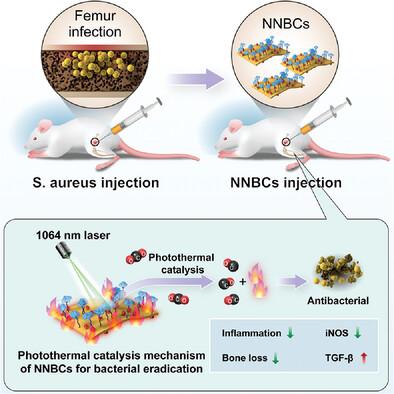Our official English website, www.x-mol.net, welcomes your feedback! (Note: you will need to create a separate account there.)
Engineering Photothermal Catalytic CO2 Nanoreactor for Osteomyelitis Treatment by In Situ CO Generation
Advanced Science ( IF 15.1 ) Pub Date : 2024-04-23 , DOI: 10.1002/advs.202402256 Fan Zhuang 1 , Luxia Jing 1 , Huijing Xiang 2 , Cuixian Li 1 , Beilei Lu 1 , Lixia Yan 1 , Jingjing Wang 1 , Yu Chen 2, 3, 4 , Beijian Huang 1
Advanced Science ( IF 15.1 ) Pub Date : 2024-04-23 , DOI: 10.1002/advs.202402256 Fan Zhuang 1 , Luxia Jing 1 , Huijing Xiang 2 , Cuixian Li 1 , Beilei Lu 1 , Lixia Yan 1 , Jingjing Wang 1 , Yu Chen 2, 3, 4 , Beijian Huang 1
Affiliation

|
Photocatalytic carbon dioxide (CO2 ) reduction is an effective method for in vivo carbon monoxide (CO) generation for antibacterial use. However, the available strategies mainly focus on utilizing visible‐light‐responsive photocatalysts to achieve CO generation. The limited penetration capability of visible light hinders CO generation in deep‐seated tissues. Herein, a photothermal CO2 catalyst (abbreviated as NNBCs) to achieve an efficient hyperthermic effect and in situ CO generation is rationally developed, to simultaneously suppress bacterial proliferation and relieve inflammatory responses. The NNBCs are modified with a special polyethylene glycol and further embellished by bicarbonate (BC) decoration via ferric ion‐mediated coordination. Upon exposure to 1064 nm laser irradiation, the NNBCs facilitated efficient photothermal conversion and in situ CO generation through photothermal CO2 catalysis. Specifically, the photothermal effect accelerated the decomposition of BC to produce CO2 for photothermal catalytic CO production. Benefiting from the hyperthermic effect and in situ CO production, in vivo assessments using an osteomyelitis model confirmed that NNBCs can simultaneously inhibit bacterial proliferation and attenuate the photothermal effect‐associated pro‐inflammatory response. This study represents the first attempt to develop high‐performance photothermal CO2 nanocatalysts to achieve in situ CO generation for the concurrent inhibition of bacterial growth and attenuation of inflammatory responses.
中文翻译:

工程光热催化二氧化碳纳米反应器用于原位二氧化碳治疗骨髓炎
光催化二氧化碳(CO2 )还原是体内产生一氧化碳(CO)以用于抗菌的有效方法。然而,可用的策略主要集中在利用可见光响应光催化剂来实现二氧化碳生成。可见光的有限穿透能力阻碍了深层组织中二氧化碳的生成。在此,光热CO2 合理开发能实现高效热效应的催化剂(简称NNBCs)和原位CO生成,同时抑制细菌增殖和缓解炎症反应。 NNBC 用特殊的聚乙二醇进行修饰,并通过铁离子介导的配位进一步用碳酸氢盐 (BC) 修饰进行修饰。暴露于 1064 nm 激光照射后,NNBC 通过光热 CO 促进高效的光热转换和原位 CO 生成2 催化。具体来说,光热效应加速了BC的分解产生CO2 用于光热催化CO生产。受益于热效应和原位 CO 产生,使用骨髓炎模型进行的体内评估证实,NNBC 可以同时抑制细菌增殖并减弱光热效应相关的促炎症反应。这项研究代表了开发高性能光热CO的首次尝试2 纳米催化剂实现原位二氧化碳生成,同时抑制细菌生长和减弱炎症反应。
更新日期:2024-04-23
中文翻译:

工程光热催化二氧化碳纳米反应器用于原位二氧化碳治疗骨髓炎
光催化二氧化碳(CO



























 京公网安备 11010802027423号
京公网安备 11010802027423号